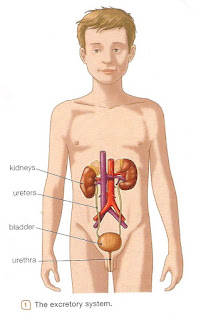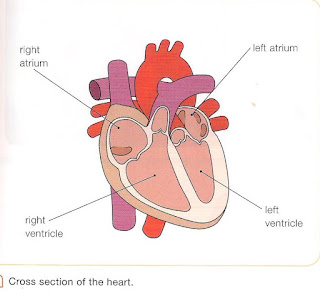NUTRIENTS
1. Read about nutrients and do these activities in your Natural Science notebook:
http://www.bbc.co.uk/schools/gcsebitesize/design/foodtech/compositionpropertiesrev1.shtml
Nutrient
|
Types
|
Function
|
Food that contains it
|
Proteins
|
Animal proteins, vegetable proteins.
|
They help the body grow
and repair itself. |
Meat, fish, cheese, milk and eggs. Soya-bean
products, pulses and nuts.
|
THE EXCRETORY SYSTEM
THE CIRCULATORY SYSTEM
The three types of blood cells
The circulatory system
The heart
Pulmonary circulation
Systemic circulation
THE RESPIRATORY SYSTEM
HOW A NEURON WORKS
BODY
http://www.softschools.com/science/human_body/
THE SENSES
Parts of the ear
Interaction activities: watch the video and complete this text in your notebook:
Complete the text in your notebook.
The eye translates light waves into images. In the eye, the eyeball has lots of different parts. The …………………………(1)is a dome of clear tissue that focuses light as it passes through. Right behind it, the coloured part of the eye is the………………………………(2) . The pupil is an ………………………(3) that lets light into the eye.
The pupil can change its size thanks to some……………………… (4) attached to them; their function is to……………………………………………………….. (5). As a result, the pupil gets ………………………… (6) when there is lots of light, and bigger when it’s dimmer. After light has passed through the cornea and the pupil, the light goes through the ………………………………(7) , which ....................................................(8) into the back of the eye. The ciliary muscles change the ……………………………….(9) of the lens to let the eye change its focus. Thus, to see something near, the ciliary muscles make the lens……………………….(10), and to see something far, the ciliary muscles make the lens………………………..(11) .
The back wall of the eyeball is the………………………….. (12). The……………………………….(13) focuses the ……………………(14) onto the retina. It contains many light sensitive cells, like ……………………………(15) and………………………………(16) . They allow us to see shapes and………………………….(17), and ……………………………..(18) . Behind the retina, the …………………………………………(19) carries messages to the brain.
How we see colour
How we see colour
THE EAR
Watch the video and complete this text in your notebook.
The............................. (1) of the ear catches (2)........................................ It faces ............................... (3) and has an especially design structure of............................... (4) helping us to determine ..............................(5) and also emphasizes the ..................................(6) used in human speech.
After the sound waves are caught they travel through the ....................................(7) and strikes against ....................................(8). The eardrum is a ....................................(9) about 10 mm wide. Now that the sound is received the ........................................(10) transfers this energy.
The smallest bones in the body, the ..........................................(11), .............................................(12) and .....................................(13) start in motion. Now the sound comes to the most complicated part, the .........................................(14), which has three chambers. At the central part there are ............................(15) that give us the signal that we heard something. There is a special structure next to these fibers containing ................................... (16) cells. When the fibers resonate they cause the ........................................(17) to move, which then send an .......................................(18) impulse to the...............................(19) and onto the brain.
Certain pitches of sound will resonate in specific......................................(20) and .......................(21) sounds will cause more.......................... (22) to move. Our brain...................................... (23) all this raw data making possible to enjoy things like music.
THE NERVOUS SYSTEM
IMMUNE SYSTEM
HE IMMUNE SYSTEM (The information I told you to search for and that most of you didn't properly bring).
Read and copy in your Science notebook.
- Investigate. The spleen, lymph nodes and bone marrow are part of one system in your body. Which one it is? What is their function?
They are part of the immune system, which is in charge of protecting our body against illnesses.
The function of the spleen is to help purify the blood by destroying old red blood cells and it can produce and store some white blood cells (responsible for detecting germs and producing antibodies).
The bone marrow is the soft, spongy area in the center of some of the larger bones of the body, which produces all of the different cells that make up the blood, such as red blood cells, white blood cells (of many different types), and platelets.
Lymph nodes are small bean-shaped organs that contain white blood cells. They are in charge of removing germs from your body and of fighting disease, and they’re connected with lymph vessels. When your body is fighting against infection, some of your lymph nodes enlarge, as they're capturing unwanted substances in your body.
In the picture below, lymph nodes are green colour.











No comments:
Post a Comment